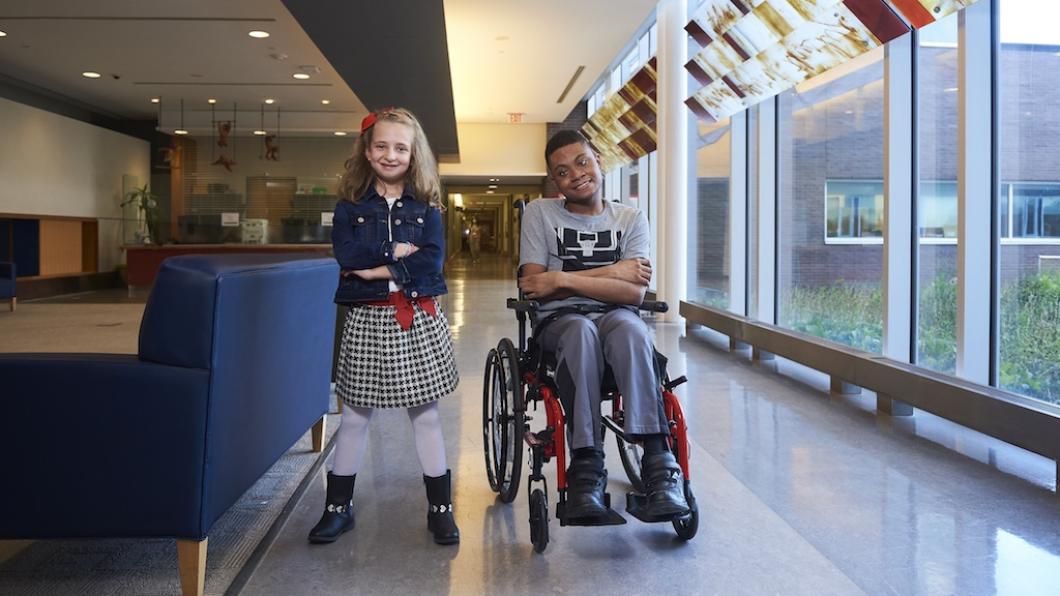
Ontario teachers get new tool to promote disability inclusion
By Louise Kinross
Project Inclusion is a learning resource for Ontario educators that's built around the voices and experiences of students with disabilities, their families, and school board staff.
The website offers five learning modules on disability, accessibility and inclusion for staff working with students in kindergarten to Grade 12. It was created by Holland Bloorview and funded by the Ontario Ministry of Education. Over 300 students, parents and Ontario school board educators helped develop the content by taking part in interviews and a survey, and reviewing material. Two teachers from Bloorview School Authority narrated the modules and teams from Holland Bloorview worked together to craft and produce them.
"What's different about this resource is that lived experiences were central to the formation of the content," says Joanne Close, project manager. "Educators have the ability to hear from people directly. They're not reading about a diagnosis or about a student, they're hearing a student talk about their experiences. That's what makes this a really valuable guide."
The content is split into five modules that include videos, practical strategies and resources. "The first includes existing Ontario legislation and how it applies to accessibility in the classroom," Joanne says. "The second delves into the importance of promoting friendships. Module three is about giving students voices and choices and student engagement. Module four looks at the importance of field trips and extra-curricular things like clubs and sports, and what that means for students with disabilities. The last module is about preparing for life after high school. A rich life means different things to different people, so we want to broaden the perspective of what a meaningful life can be."
Joanne says she wishes this kind of resource was available when her son was in school. "He has a diagnosis of autism and intellectual disability, so for me, a lot of this work is close to home," she says. "In my son's case, he didn't fit any profile neatly, so there was an issue of ''Where do we put him?' and 'What do we do?' There's a lot of diversity in neurodiversity, and that was true in his case. People were uncomfortable talking about what would make a good experience for him. What this resource does is open a conversation."
Joanne says one of the key messages is that inclusion starts early and covers all facets of education. "One of the videos is of a woman who was a very strong advocate for her son and who is now a school principal. She talks about why all students should be included in field trips, and why trips need to be accessible for everybody. Then there's a fantastic example where a student talks about her Grade 8 school trip. She has a physical disability, and her mother worked with the vice-principal to plan events that would be accessible for her. But when she got there, nothing had been done. Hearing someone talk about the impact of that really brings it home."
Before planning content for Project Inclusion, students and educators took part in empathy interviews led by Kathryn Parker, senior director of Academic Affairs at Holland Bloorview. "These were deep dives where you ask people how they feel about something and there's no right or wrong," Joanne says. "That helped us develop a summary of what we were hearing, and what we needed to do in terms of content."
Joanne says a key concern of educators was that they feared making a mistake or not doing the right thing when it came to working with students with disabilities. "They want to be inclusive and they want to know how to do it," she says. "But they're afraid of not meeting students' needs. They also have a lot on their plate."
For each Project Inclusion module, an accessible PDF is available which summarizes the content and includes links to additional resources. "That decreases the cognitive load for teachers when looking at the screen, so they don't have to worry about writing everything down," Joanne says.
Project Inclusion can be accessed in French or English and is closed captioned. A facilitator's guide can be downloaded and used for small group discussions or Lunch and Learns using specific themes.
Joanne says the greatest challenge of bringing the resource to life was "honouring voices. We wanted to make sure the voices came through unedited, so educators would be able to hear people directly and we'd honour the range of diversity out there."
Please share Project Inclusion with families and educators. It's an extension of Holland Bloorview's Dear Everybody campaign, which began five years ago with an open letter from children with disabilities and their families that pushed readers to confront their own biases about disability. Like this story? Sign up for our monthly e-letter: https://bit.ly/3IIK5Qo.